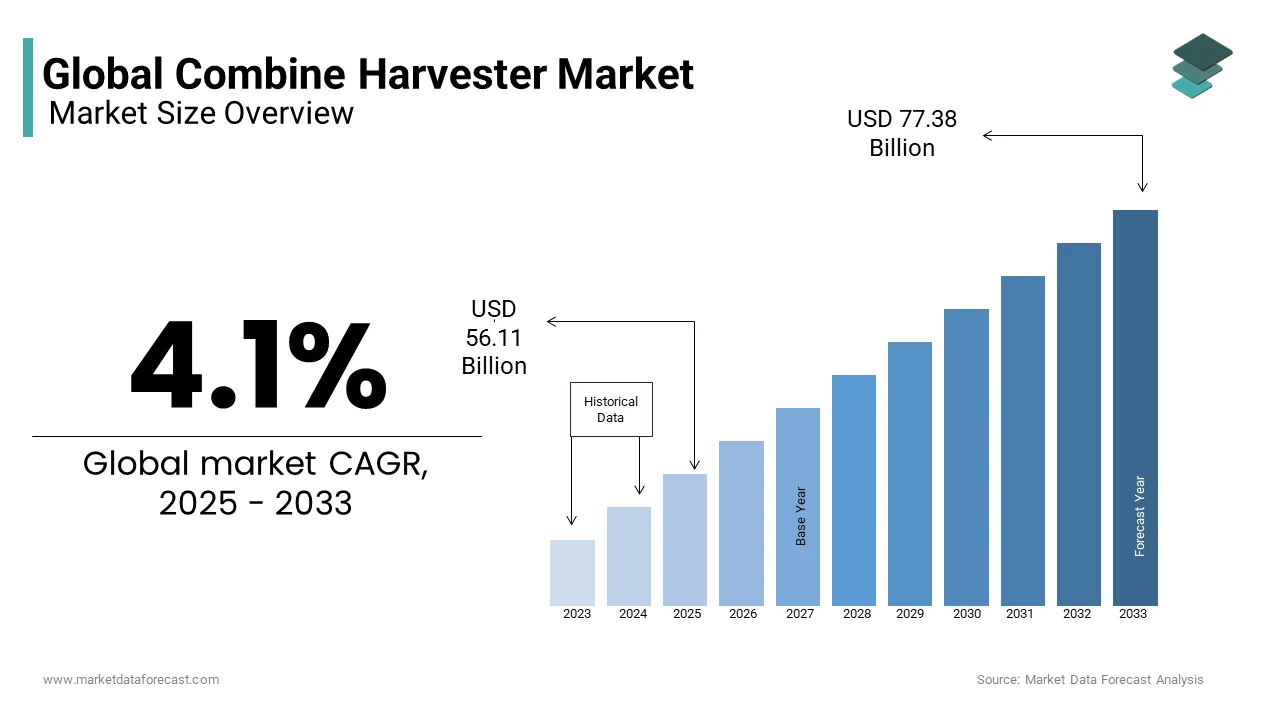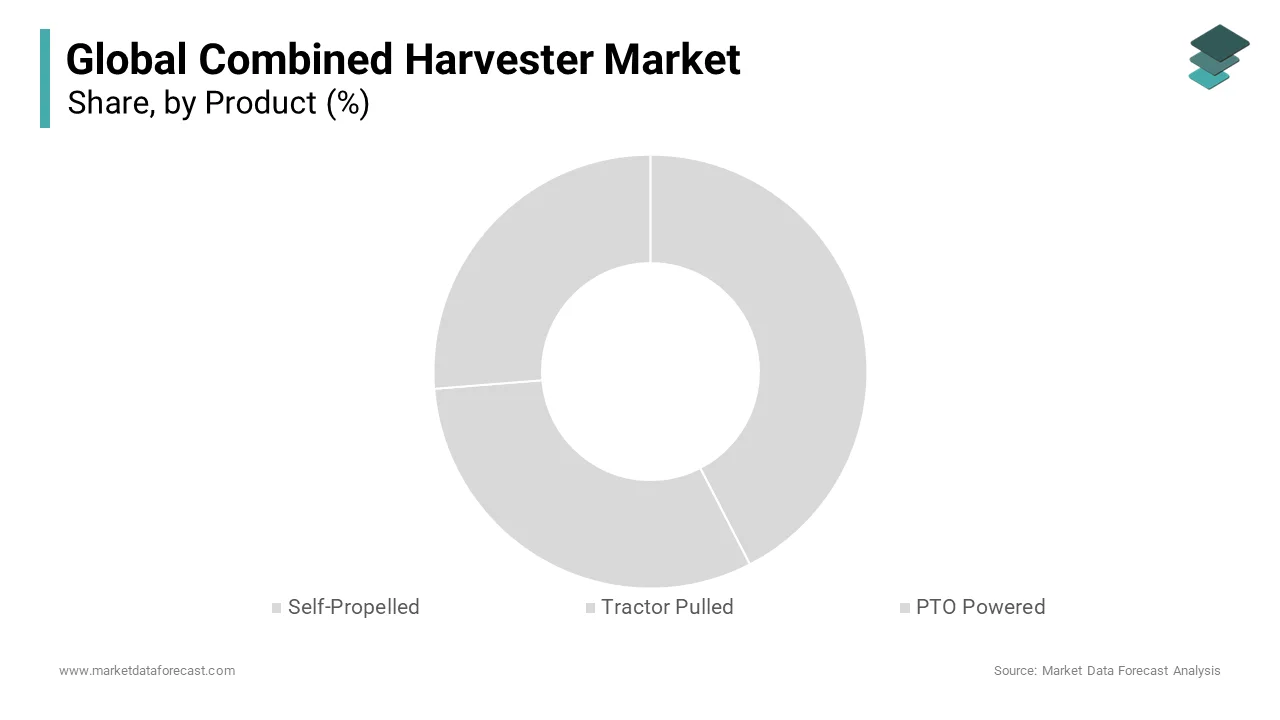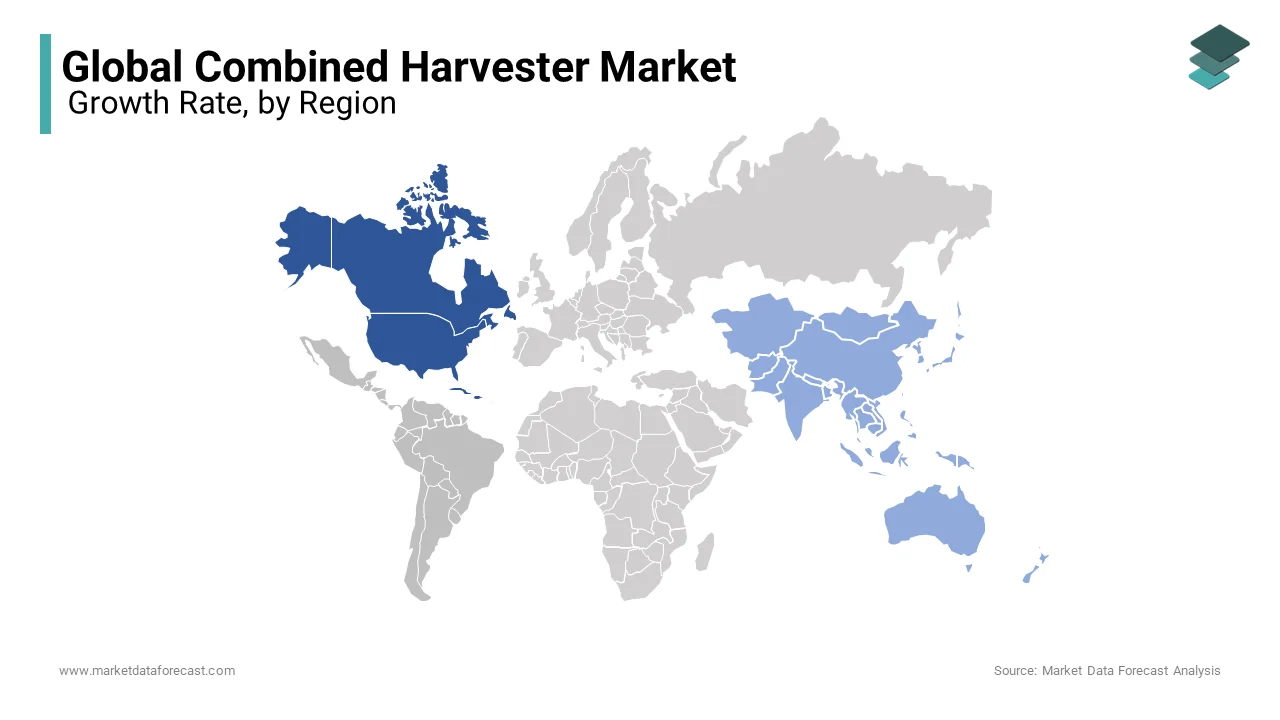Global Combine Harvester Market Size, Share, Trends & Growth Forecast Report - Segmented By Product (Self-Propelled, Tractor Pulled And PTO Powered), Class (Class 4 And 5, Class 6, Class 7, Class 8 And Class 9 And 10), And By Region (North America, Europe, Asia Pacific, Latin America, and Middle East and Africa) - Industry Analysis From 2025 to 2033
Global Combine Harvester Market Size
The global combined harvester market was valued at USD 53.90 billion in 2024 and is anticipated to reach USD 56.11 billion in 2025 from USD 77.38 billion by 2033, growing at a CAGR of 4.1% during the forecast period from 2025 to 2033.

A combine harvester is a versatile machine designed to make the process of harvesting crops more efficient. Automation is an important aspect of agriculture, and so is mechanization, and combined harvesters are one of the basic steps in achieving this.
Combine harvesters perform the three processes of reaping, threshing and winnowing in a single machine and hence the name combine harvester. Combine Harvester are very economical and boast labour saving as its main advantage. In spite of several great advances in mechanics and computer control, the basic operating principle of the combine harvester has remained unchanged almost since it was invented.
MARKET DRIVERS AND RESTRAINTS
The growth of the combine harvester market is mainly driven by the shorter harvest periods due to changing climatic conditions. With the weather conditions taking a turn for the worst, the harvest periods are expected to keep being erratic and short. This is prime territory for the flourishment of the combine harvester market. Other drivers of the market include the increasing acceptance of automated equipment, rising consumer awareness and the research and development done in the field. As for the restraints of the market, the initial high costs of buying the equipment and the maintenance costs are the major turn-offs for the market. Also, some degree of technical knowledge is needed for the operation of the machines, which might be a problem in developing and underdeveloped countries where farmers lack the required technical skills.
REPORT COVERAGE
|
REPORT METRIC |
DETAILS |
|
Market Size Available |
2024 to 2033 |
|
Base Year |
2024 |
|
Forecast Period |
2025 to 2033 |
|
CAGR |
4.1% |
|
Segments Covered |
By Product, Class and Region |
|
Various Analyses Covered |
Global, Regional & Country Level Analysis, Segment-Level Analysis, DROC, PESTLE Analysis, Porter’s Five Forces Analysis, Competitive Landscape, Analyst Overview on Investment Opportunities |
|
Regions Covered |
North America, Europe, APAC, Latin America, Middle East & Africa |
|
Market Leaders Profiled |
AGCO, CLAAS, CNH Industrial, Deere & Company, Dewulf, Kubota Agricultural Machinery, Kuhn Group, Lely Group, Lovol Heavy Industry, Ploeger, Pottinger, Preet Group, SDF, Sampo Rosenlew, and Others. |
SEGMENT ANALYSIS

REGIONAL ANALYSIS

The combined harvester market was dominated by North America in 2017, with the region accounting for 36% of the overall market share. North America was followed next in line by Europe and Asia-Pacific. Asia-Pacific is expected to grow rapidly in the coming years as is evident from the high CAGR value for the region. Another promising region for the market is Latin America, which is expected to show high growth rates in the coming years.
KEY MARKET PLAYERS
AGCO, CLAAS, CNH Industrial, Deere & Company, Dewulf, Kubota Agricultural Machinery, Kuhn Group, Lely Group, Lovol Heavy Industry, Ploeger, Pottinger, Preet Group, SDF, Sampo Rosenlew. Some of the market players dominate the global combine harvester market.
MARKET SEGMENTATION
This research report on the global combined harvester market is segmented and sub-segmented into the following categories:
By Product
- Self-Propelled
- Tractor Pulled
- PTO Powered
By Class
- Class 4 and Class 5
- Class 6
- Class 7
- Class 8
- Class 9 and Class 10
By Region
- North America
- Europe
- Asia Pacific
- Latin America
- Middle East and Africa
Frequently Asked Questions
What is the current market size of the global combine harvester market?
The current market size of the global combined harvester market was valued at USD 56.11 billion in 2025.
What are the market drivers that are driving the global combine harvester market?
The shorter harvest periods due to changing climatic conditions and increasing acceptance of automated equipment, rising consumer awareness are the market drivers that are driving the global combine harvester market.
Who are the market players that are dominating the global combine harvester market?
AGCO, CLAAS, CNH Indusrial, Deere & Company, Dewulf, Kubota Agricultural Machinery, Kuhn Group, Lely Group, Lovol Heavy Industry, Ploeger, Pottinger, Preet Group, SDF, Sampo Rosenlew. Some of the market players dominating the global combine harvester market.
Related Reports
Access the study in MULTIPLE FORMATS
Purchase options starting from
$ 2500
Didn’t find what you’re looking for?
TALK TO OUR ANALYST TEAM
Need something within your budget?
NO WORRIES! WE GOT YOU COVERED!
Call us on: +1 888 702 9696 (U.S Toll Free)
Write to us: sales@marketdataforecast.com